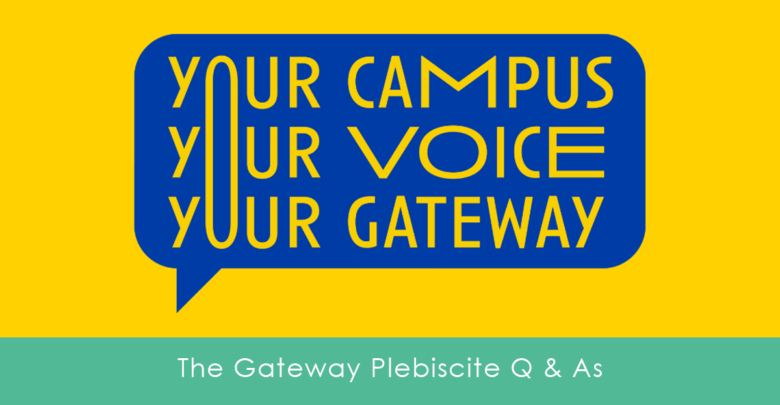SU Elections 2021 Q&A: The Gateway Plebiscite
As The Gateway reaches its funding renewal period, read up about how much the fee costs and what value is provided to students.
 Pia Co
Pia CoAs students vote in a new Students’ Union executive team, they will also have the opportunity to decide on renewing The Gateway‘s dedicated fee unit (DFU).
This $3.54 fee for full-time Fall and Winter students helps cover the costs of producing content for both The Gateway‘s online and magazine publications. Students cannot opt-out of the fee and Augustana students are exempt.
Representing The Gateway Plebiscite in this Q&A is Lochlann Kerr, a third-year political science student, Gateway contributor, and co-manager of The Gateway‘s plebiscite campaign.
Follow this link to watch The Gateway’s plebiscite pitch video.
The following interview has been condensed and simplified for clarity.
To read The Gateway‘s conflict of interest statement about our campaign, please consult this.
What is this plebiscite trying to accomplish?
Lochlann Kerr: The plebiscite exists to give students at the U of A the opportunity to re-affirm their commitment to funding the give to The Gateway. Every five years this plebiscite, which largely looks the same since it was first created in 2002, allows The Gateway to make sure it stays honest and true to the mandate students give them. This year we will be asking students if they want to continue the Gateway’s 110-year legacy by continuing the $3.54 fee they already pay.
The plebiscite ensures that The Gateway can continue being the student media organization and monthly magazine that U of A students deserve and need for the next 110 years.
For those who don’t know, what is the Gateway?
Kerr: The Gateway is a student-run, not-for-profit campus media outlet. It was founded in 1910, so it’s the 110 anniversary this year. What it operates as throughout its history has changed, but at its core, it’s always been driven by student volunteers and staff who strive to produce informative journalism for the U of A community, as well as creating a space for student voices through things like editorials and arts and culture coverage.
The Gateway essentially provides students with a journalism program, which is tragically missing at the U of A. It’s not just a space to see great journalism and stay informed about what’s happening on campus, it gives tons of volunteers opportunities to get real experience because we provide training, professionalization, and the support students need to not only become better writers, but to become strong journalists, photojournalists, and creators. We’ve had about 50 volunteers writing this year. This kind of service has always been at the core of The Gateway, so long as it is a source of journalism on campus, will be striving to provide at the U of A.
If this plebiscite passes, how much will students be paying and how was this cost determined?
Kerr: The fee will be $3.54 per student each semester, and it is not paid by Augustana students. In the spring and summer term it is 54 cents per semester. This fee alongside a combination of advertising revenue that The Gateway sources through selling advertisements and doing partnerships with organizations and businesses around the city, goes towards funding its operation. The fee is essentially determined each year by inflation, so it increases a bit each year to make sure students are actually paying the same amount that they have been paying for decades.
This fee goes towards ensuring The Gateway can continue its operations. This includes paying for things like professionalization, the equipment the photojournalists use, and publishing the monthly magazine. It is also used for tools of investigative journalism like Freedom of Information Press (FOIP) requests, which The Gateway can use to dive into behind the scenes of the university’s operations and do the investigations that students deserve to have done into their own university.
Why should students care about the Gateway?
Kerr: I think it comes down to two ways The Gateway provides value at its core. The first is being a vital source of student journalism. Even when we’re not together on campus, there is so much happening at the U of A. So many stories only get covered by The Gateway. Things like the penguin protest a few weeks ago where The Gateway was one of the only reporters on the grounds as those penguins were being set up and reported on it before anyone else. It looks like things like covering academic restructuring, which will massively impact the student experience for years to come. It’s covering Students’ Union elections so students know who to vote for. That kind of essential journalism coverage only happens because The Gateway is here. It’s the best value for your money that you’re getting for a journalism subscription. The New York Times costs way more — for just $3.54 you are getting some great campus journalism compared to the amount of money you would be paying for other newspapers.
The second area of value for students is for those who volunteer so much of their time at The Gateway. I got involved with The Gateway because I wandered into their office and asked the first person I saw to teach me how to write a news article. A week later, I got to feel that great feeling of publishing the first news article I’ve written. I’ve gotten training, I’ve gotten experience — I got a portfolio of journalism that I can bring with me through the rest of my career, both at the U of A and beyond. I also had the ability to have my voice heard, voice opinions, see my arts and culture experiences reflected at The Gateway. This is why The Gateway is essentially the U of A’s unofficial journalism program. It has massive value for those who are involved. So there is a broad campus value for every single student and then specific value to students who join us at The Gateway each and every year.




